Health Care > EXAM > NR 222 RN HESI Exit Exam Remediations; Questions & Answers/ Newly Updated with Rationales; Guarantee (All)
NR 222 RN HESI Exit Exam Remediations; Questions & Answers/ Newly Updated with Rationales; Guaranteed A+
Document Content and Description Below
RN HESI Exit Exam Remediation The nurse is caring for a client who has a fiberglass long leg cast on the right leg. Which nursing actions should be implemented in the cast care of this client? SA... TA a) Smelling the cast and feeling for the presence of hot spots on the cast. b) Checking neurovascular status of the right exposed foot and toes every four hours. c) Using a soft cotton-tipped 6-inch swab to help scratch beneath the cast. d) Placing the nurse's finger in the client's cast while performing cast care. e) Covering the perineal area of the cast with plastic before client uses the fracture bedpan. a) Smelling the cast and feeling for the presence of hot spots on the cast. b) Checking neurovascular status of the right exposed foot and toes every four hours. d) Placing the nurse's finger in the client's cast while performing cast care. e) Covering the perineal area of the cast with plastic before client uses the fracture bedpan. Rationale Cast care should include ensuring the cast is not too tight, by placing a finger between the client's skin and cast; by protecting the cast from being soiled by placing a protective plastic covering in the perineal area before the client uses a bedpan; by smelling for a foul odor coming from the cast; by palpating for hot spots on the cast every shift; and by performing neurovascular checks distal to the cast every four hours. Nothing should be placed in the cast to facilitate scratching beneath the cast. The nurse is caring for an older client being treated for a cardiac condition who has developed "dry eyes". Which medication may be contributing to this condition? a) Procainamide (Procanbid). b) Iron supplements. c) Atenolol (Tenormin). d) Lipitor (Atorvastatin). c) Atenolol (Tenormin). Rationale Dry eyes is an annoying side effect of some medications that can cause a client to feel like they have something in their eye or a continuous scratchy sensation. This condition can cause eye strain and discomfort to a client. Clients prescribed Atenolol for hypertension are at risk of developing dry eyes as a side effect of the medication. The UAP is assisting a client getting into the shower. The charge nurse answers a call from the cast clinic to immediately send the UAP's other assigned client to the clinic. Which action should the nurse take? a) Ask the UAP to find another team member to take the client to the clinic. b) Notify the delegating nurse of the current request from the cast clinic. c) Instruct the UAP to take the client to clinic after helping the other client taking a shower. d) While the client is showering the UAP should take the other client to cast clinic. b) Notify the delegating nurse of the current request from the cast clinic. Rationale The charge nurse should notify the delegating nurse of the situation. The third principle of delegation is "The person to whom the assignment was delegated cannot delegate that assignment to someone else... the delegating nurse needs to be notified and reassign the task..." During a literature review for a research study, the nurse discovers a separate study has already proved the proposed hypothesis to be true. Which action should the nurse take regarding the proposed research study? a) Discontinue the research. b) Revise the hypothesis of the current study so it is unique. c) Perform the current study as a replication study. d) Contact the authors of the original study for permission to continue. c) Perform the current study as a replication study. Rationale Because of inherent scientific error that may exist within all research studies, hypotheses require more than one test to support their accuracy. A critical weakness with nursing research is a lack of replication. Retesting a hypothesis that has been shown to be true strengthens the findings of the earlier study and supports the use of those findings to influence clinical practice. In assessing the scrotum of a male client, which finding would need to be reported to the healthcare provider? a) Asymmetric appearance. b) Taut appearance of skin surface. c) Deeper pigmentation of the underside. d) Presence of sebaceous cysts. b) Taut appearance of skin surface. Rationale The skin surface of the scrotum should appear coarse, rather than taut, which may indicate swelling or edema and should be reported to the healthcare provider. Which nursing intervention should the nurse implement when caring for a child with nephrotic syndrome? a) Take vital signs every 2 hours. b) Restrict the number of visitors. c) Reposition the client every 2 hours. d) Monitor fluid intake and urine output. d) Monitor fluid intake and urine output. Rationale Due to the pathophysiology of nephrotic syndrome, decreased colloidal osmotic pressure in the capillaries is decreased, resulting in overall body edema. Treatment usually includes infusion of 25% albumin and use of diuretics to help pull fluids out of the interstitial tissues back into the vascular system. Fluid intake and urine output should be carefully monitored to prevent hypervolemia and edema and monitor the efficacy of the medical interventions. A six-year-old client, who received a kidney transplant presents with signs including fever, decreased urine output, and tenderness over the transplanted organ. Laboratory results reveal an elevated serum creatinine level. This presentation is likely due to which cause? a) Immunosuppression medications. b) Obstructive uropathy. c) Transplant rejection. d) Nephrotic syndrome. c) Transplant rejection. Rationale Transplant rejection is caused by the recipient's immune system response to foreign tissue. Signs that may alert the nurse to rejection of a kidney transplant include fever, tenderness over the graft area, decreased urine output, and elevated serum creatinine. A child recently treated for strep throat presents with gross hematuria, facial swelling, and elevated blood pressure. Laboratory tests reveal proteinuria and azotemia. Which condition should the nurse suspect? a) Acute pyelonephritis. b) Acute glomerular nephritis. c) Nephrotic syndrome. d) IgA nephropathy. b) Acute glomerular nephritis. Rationale Acute glomerulonephritis (GN) usually manifests after strept throat or other streptococcal infection. Typical signs of acute GN include gross hematuria, facial edema, hypertension, and proteinuria. A child who is recovering from surgery for removal of a Wilms tumor develops abdominal pain and distension, absence of bowel sounds, and vomiting. Which complication should the nurse suspect? a) Intestinal obstruction. b) Abdominal peritonitis. c) Pyloric stenosis. d) Infectious gastritis. a) Intestinal obstruction. Rationale Surgical intervention for Wilms tumor involves removal of the tumor, which requires either a partial or radical nephrectomy. Small bowel obstruction is one of the most common postoperative complications following removal of a Wilms tumor. A child diagnosed with Wilms tumor is being treated with dactinomycin. What class of drug is this medication? a) Mitotic inhibitor. b) Antitumor antibiotic. c) Corticosteroid. d) Alkylating agent. b) Antitumor antibiotic. Rationale Dactinomycin, also known as actinomycin D, is an anti-tumor antibiotic used in the treatment of a variety of cancers, including Wilms tumor. The nurse is reviewing medication education with a client who was prescribed triamcinolone (Dermasorb) for the treatment of eczema. Which statement by the client indicates the client misunderstands safe administration? a) Apply to affected areas, avoiding contact with the eyes. b) Continue to apply medication for a few days after area has cleared. c) Cover weeping or denuded areas with an occlusive dressing after medication application. d) Affected areas treated with the medication can burn easily with sunlight exposure. c) Cover weeping or denuded areas with an occlusive dressing after medication application. The nurse explains to a new staff member that the goals of the therapeutic milieu for eating disorder are designed to help a client establish more adaptive behavioral patterns and develop normal eating habits. Which environmental characteristics of the milieu should the nurse include? a) Precise meal times, adherence to the selected menu, observation during and after meals, and regularly scheduled weighing. b) Client freedom to decide when and what to eat, observation before and after meals, and no weighing for the first week. c) Menus that can be altered to suit the client's taste, observation before and after meals, and regular weighing. d) Client freedom to design the meals, infrequent observation to allow the client some space, and daily weighing. a) Precise meal times, adherence to the selected menu, observation during and after meals, and regularly scheduled weighing. The nurse is assessing the femoral insertion site of a client who recently had a cardiac catheterization. The client reports discomfort at the site. According to the standing orders, which action should the nurse implement? (Click on the chart tab for additional information. Please scroll to the bottom right corner to view all information contained in the client's medical record.) Vital signs: 1.Every 15 mins x4; then every 30 mins x 4; then every 1 hour x 2 and then 4 times daily while awake. 2. Notify Cardiologist for symptomatic hypotension; systolic BP less than 90; heart rate less than 50 beats/minute. Activity: 1.Bedrest for 6 hours; HOB less than 30 degrees for 6 hours 2.(R) leg straight for 6 hours with a 5 pounds weighted sandbag at femoral insertion site. Medications: 1. Aspirin (ASA) 325mg (1) tablet PO daily 2. Acetaminophen 300mg/ codeine phosphate 30mg (Tynelol #3) 1 to 2 tablet PO every 4 to 6 hours as needed Additional prescriptions: 1.Check cath insertion site ; distal pulses to cath insertion site; (R) leg extremity for color, temperature and movement with vital signs. 2. If bleeding occurs at femoral puncture site; apply manual pressure and notify physician if bleeding doesn't stop after 5 minutes. a) Notify the healthcare provider. b) Administer acetaminophen/ codeine phosphate. c) Place an ice pack to area of discomfort. d) Apply manual pressure to insertion site. b) Administer acetaminophen/ codeine phosphate. A nurse is assigned the care of a client who is presently experiencing hypovolemic shock. The client's MAP has decreased by 20 mmHg from its baseline, tissue ischemia and anoxia of nonvital organs is occurring, pulses are weak, urine output is absent and the client's skin is cool and moist. The client appears to be confused and extremely anxious. Which stage of hypovolemic shock do these clinical signs and symptoms indicate? a) Initial stage. b) Refractory Stage. c) Progressive stage. d) Non-progressive stage. c) Progressive stage. The nurse is assessing a client's cranial nerves. How can the nurse test cranial nerve VI? a) Perform the pupillary response to light. b) Perform the Webber and Rinne tests. c) Perform the shoulder shrug against resistance. d) Perform the six cardinal fields of gaze test. d) Perform the six cardinal fields of gaze test. [Show More]
Last updated: 1 year ago
Preview 1 out of 46 pages
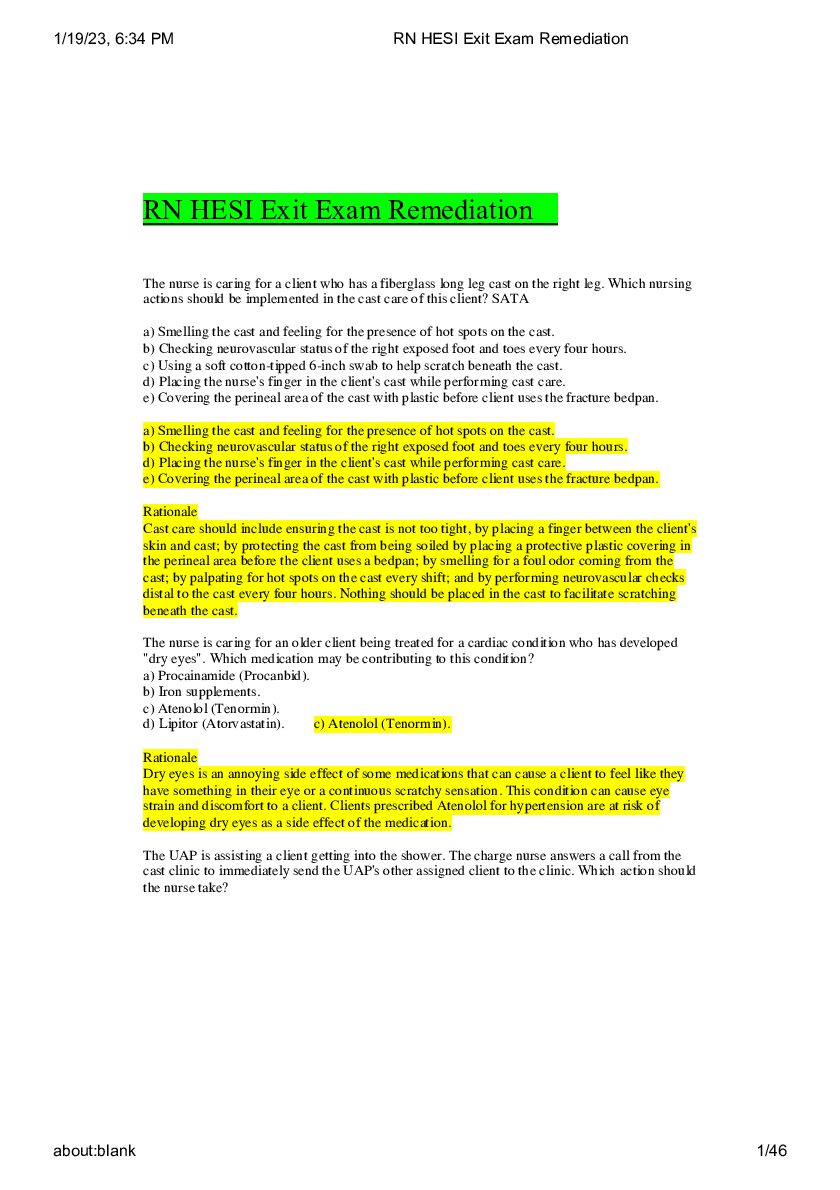
Reviews( 0 )
Document information
Connected school, study & course
About the document
Uploaded On
Sep 22, 2022
Number of pages
46
Written in
Additional information
This document has been written for:
Uploaded
Sep 22, 2022
Downloads
0
Views
33




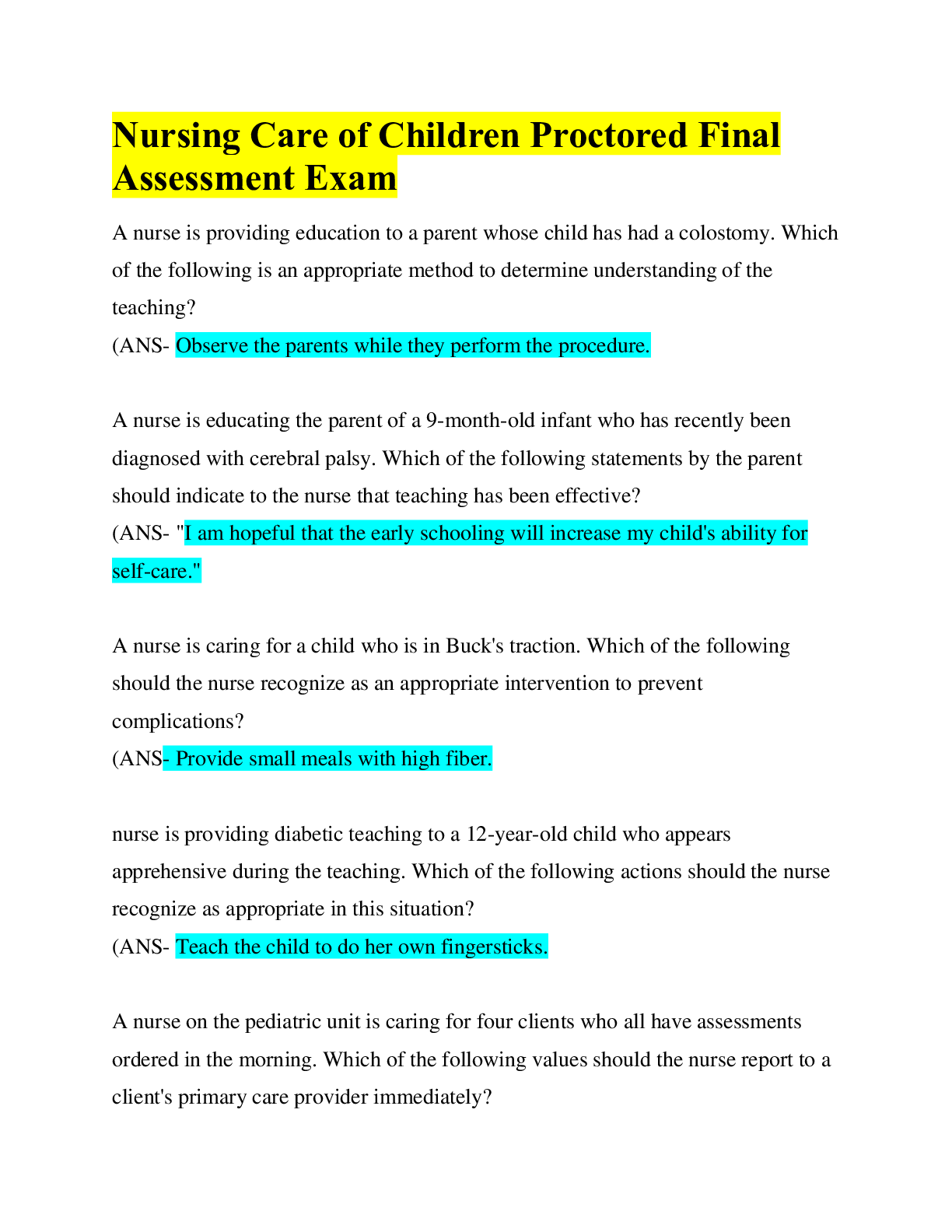
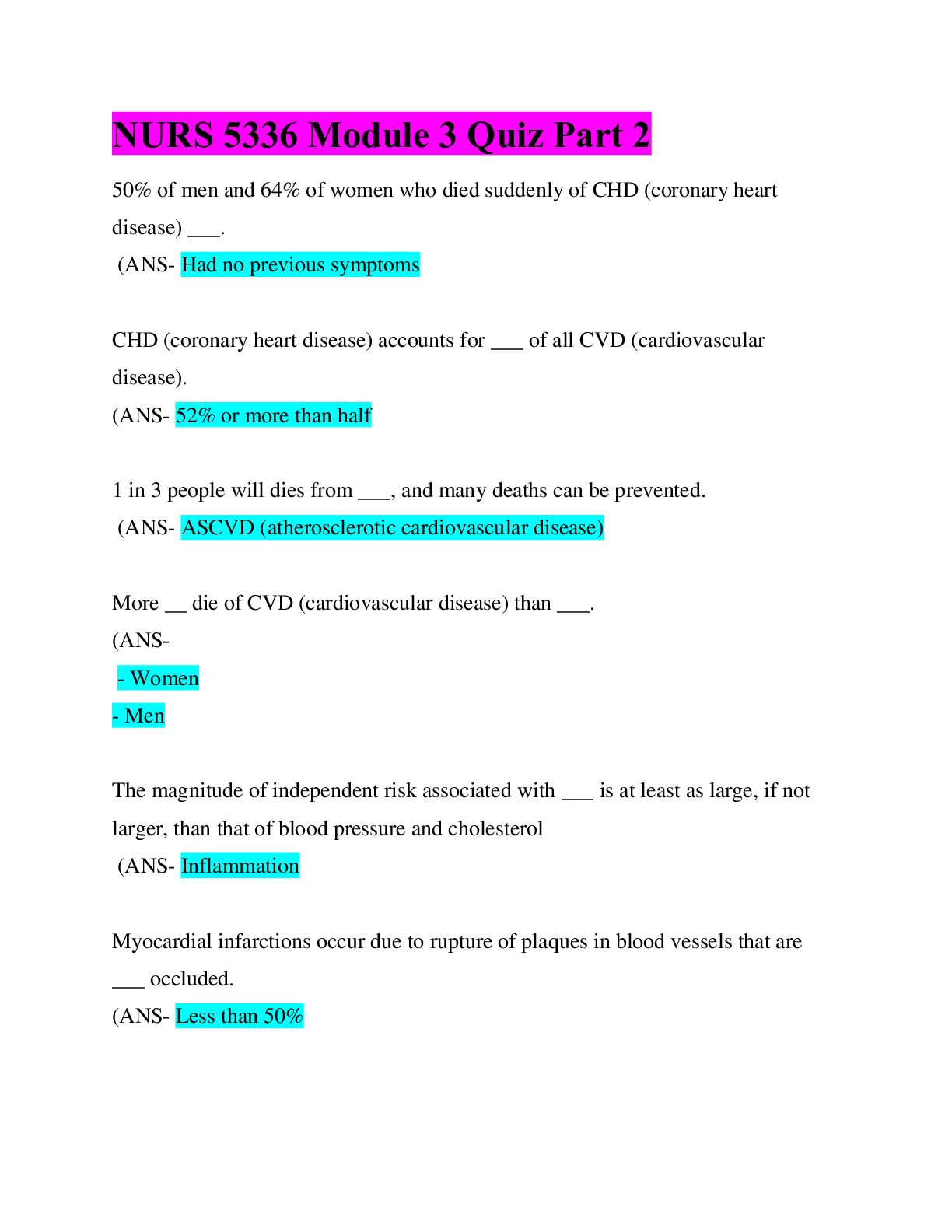
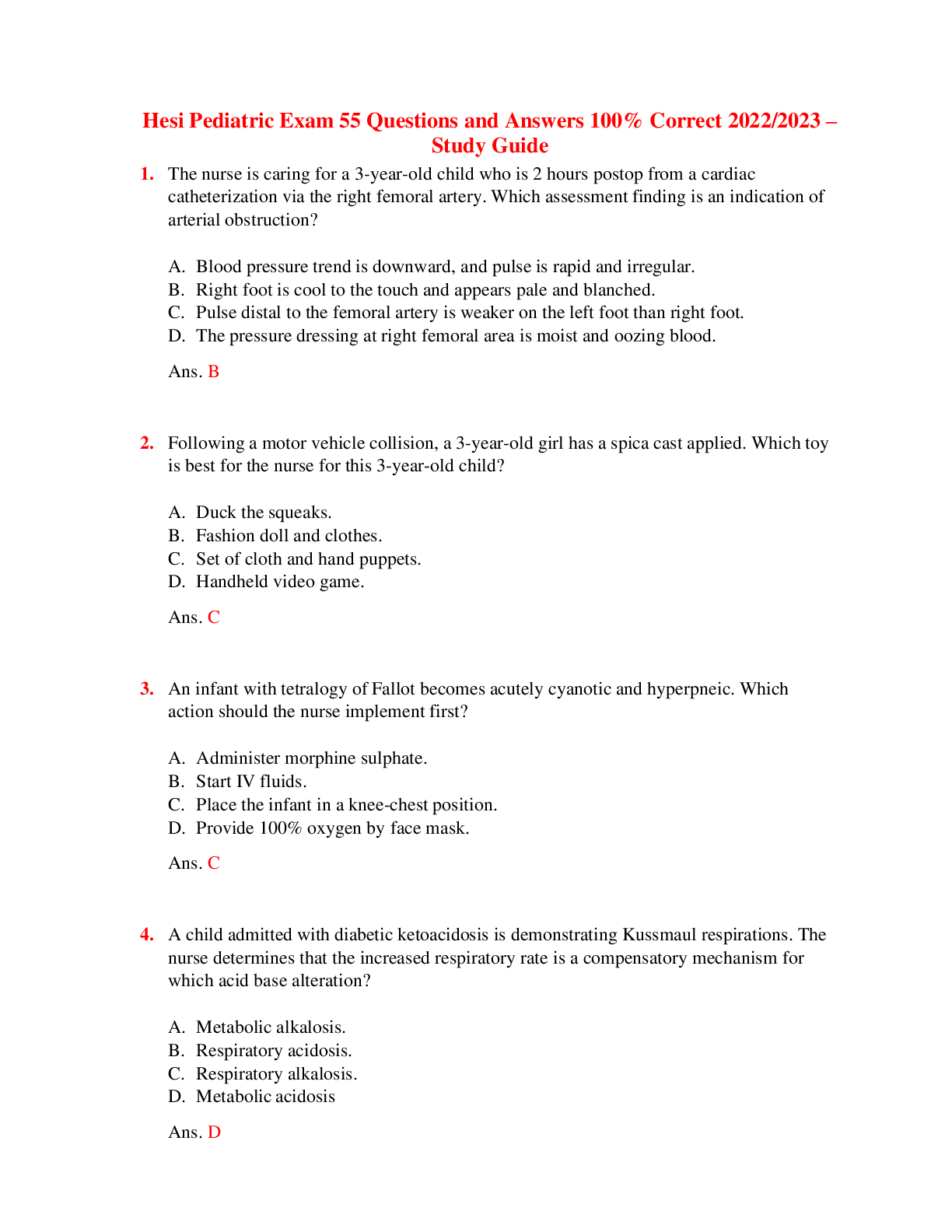

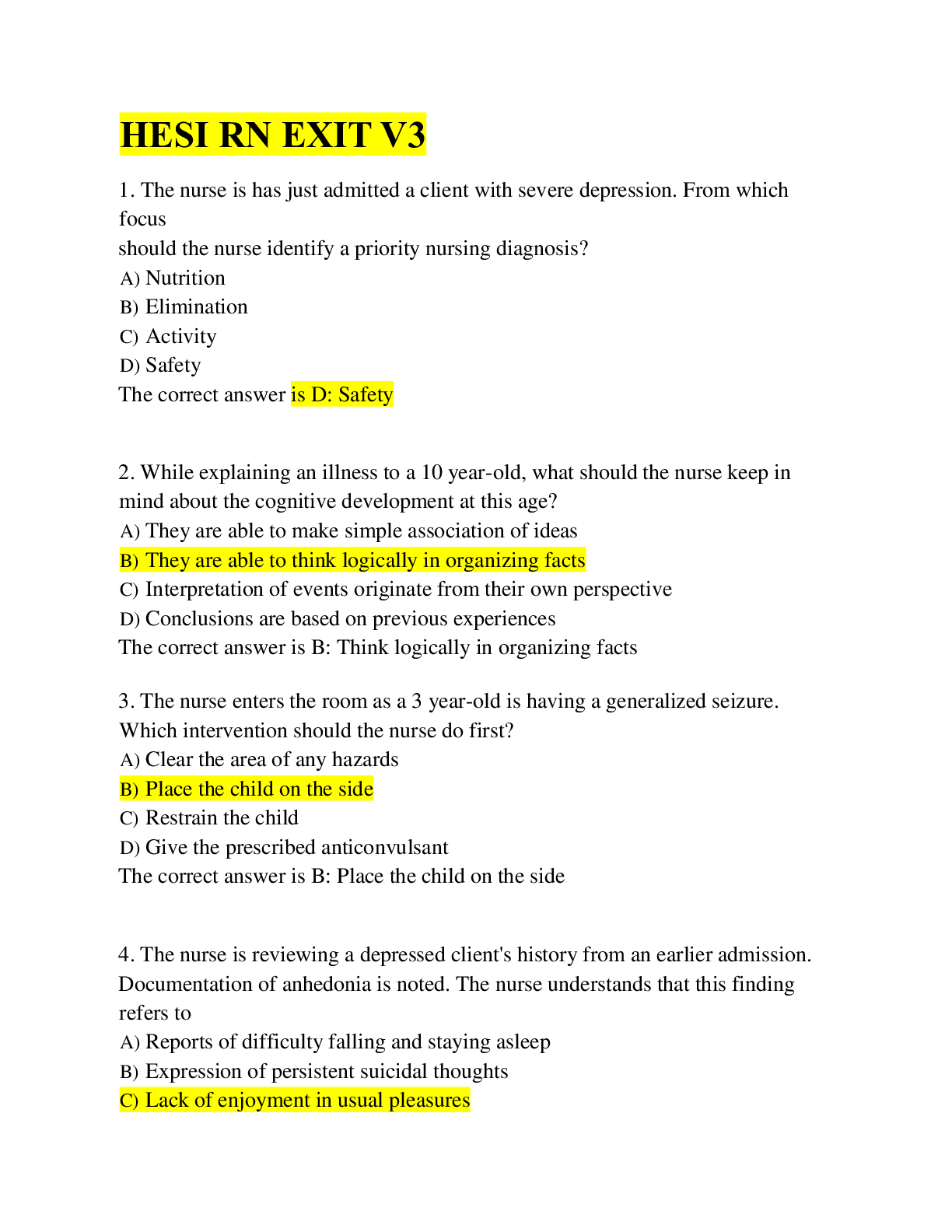
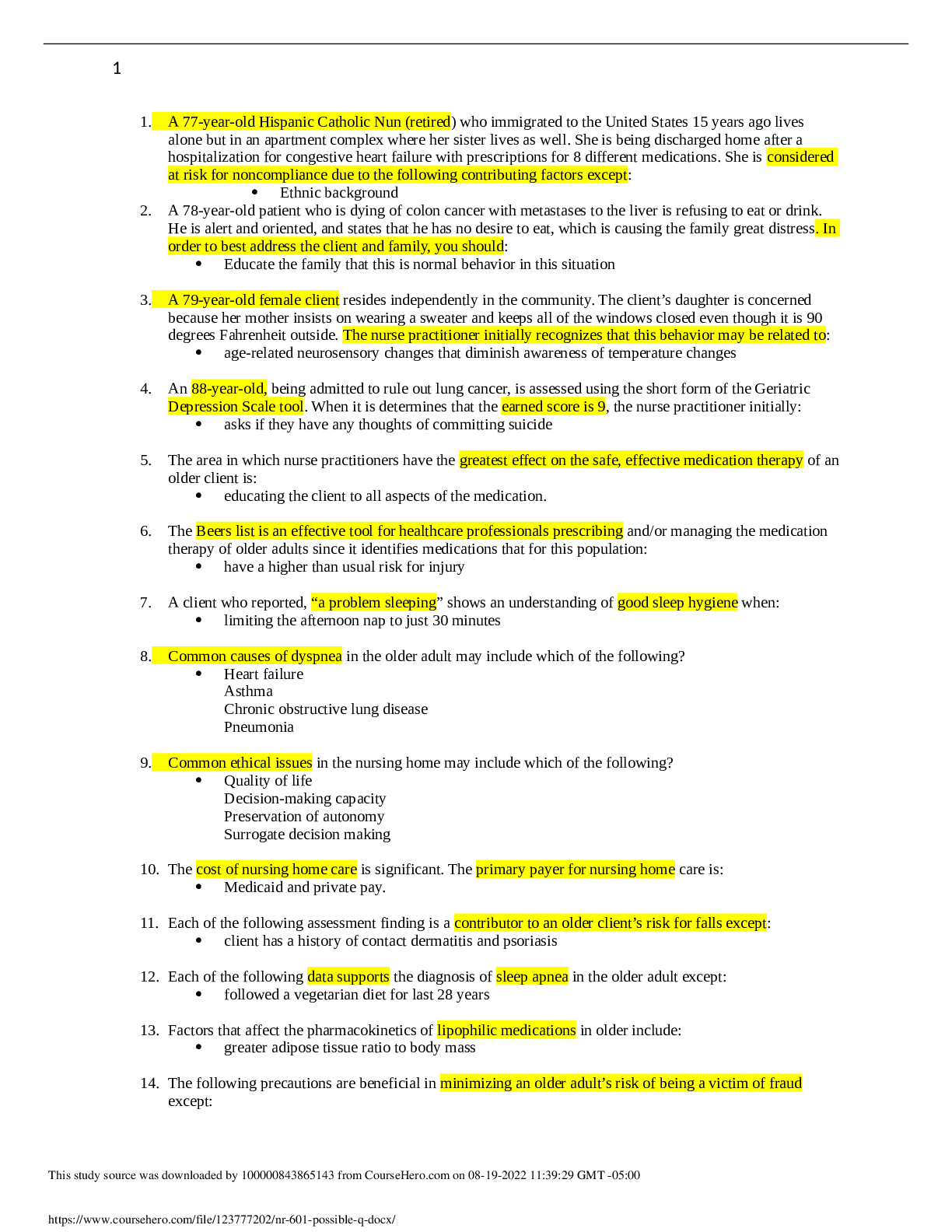
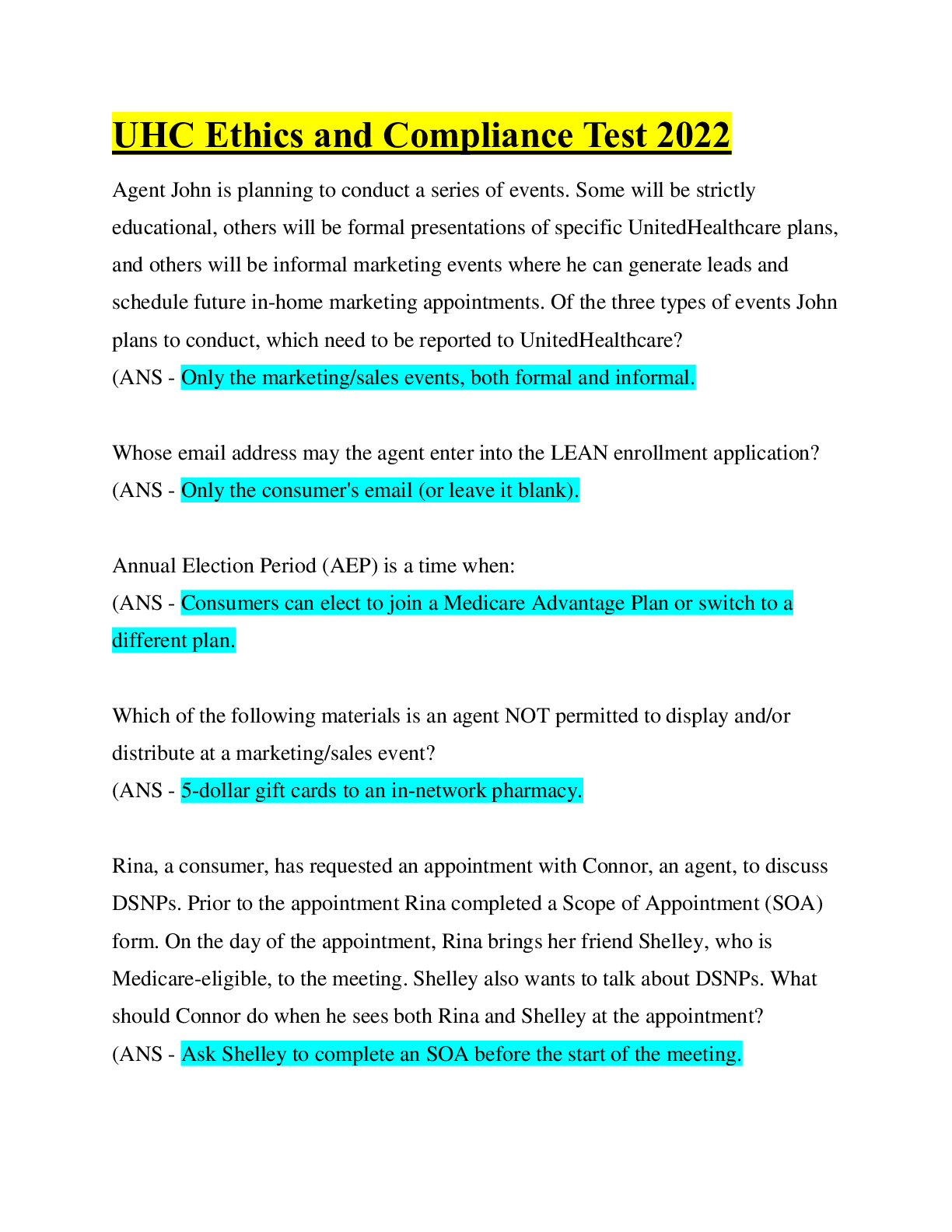

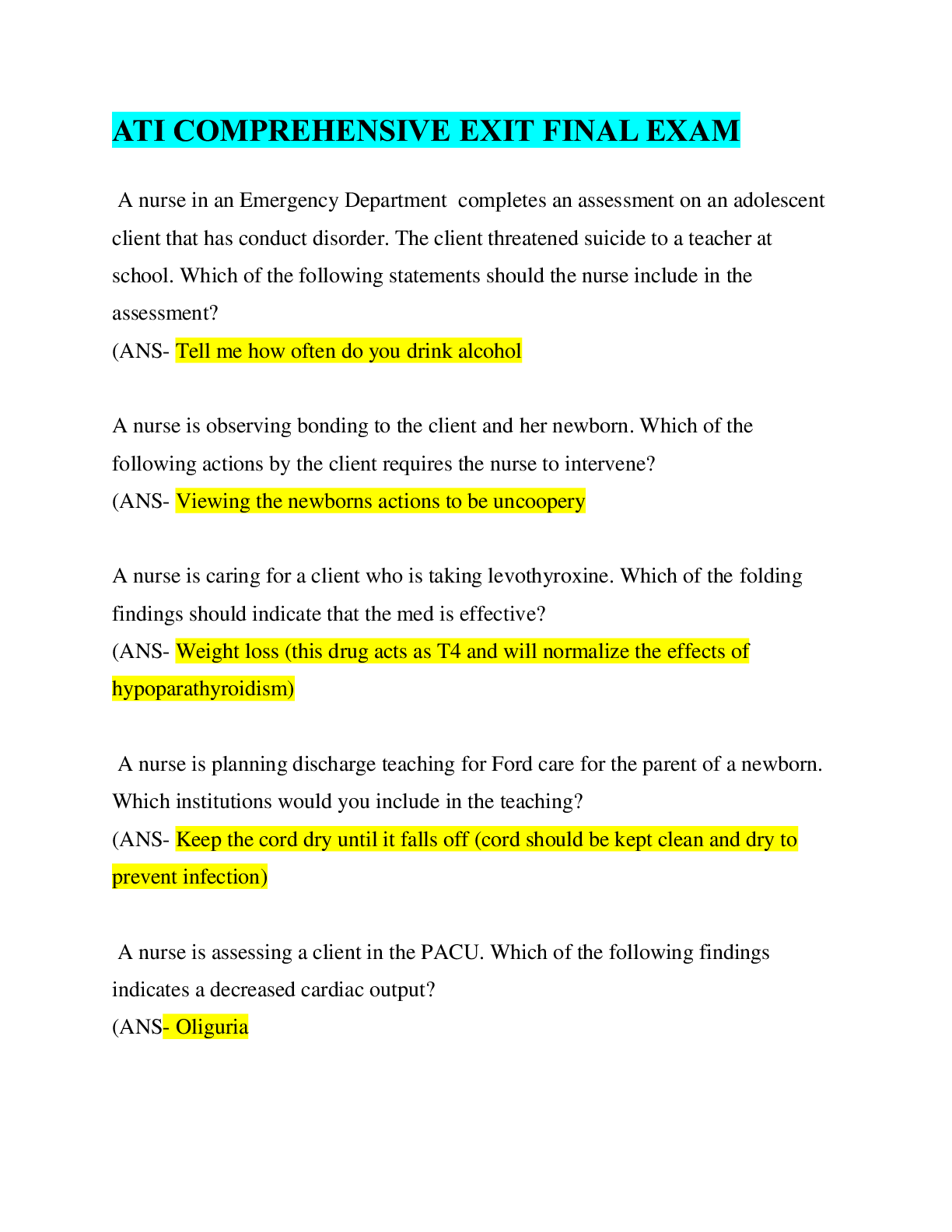
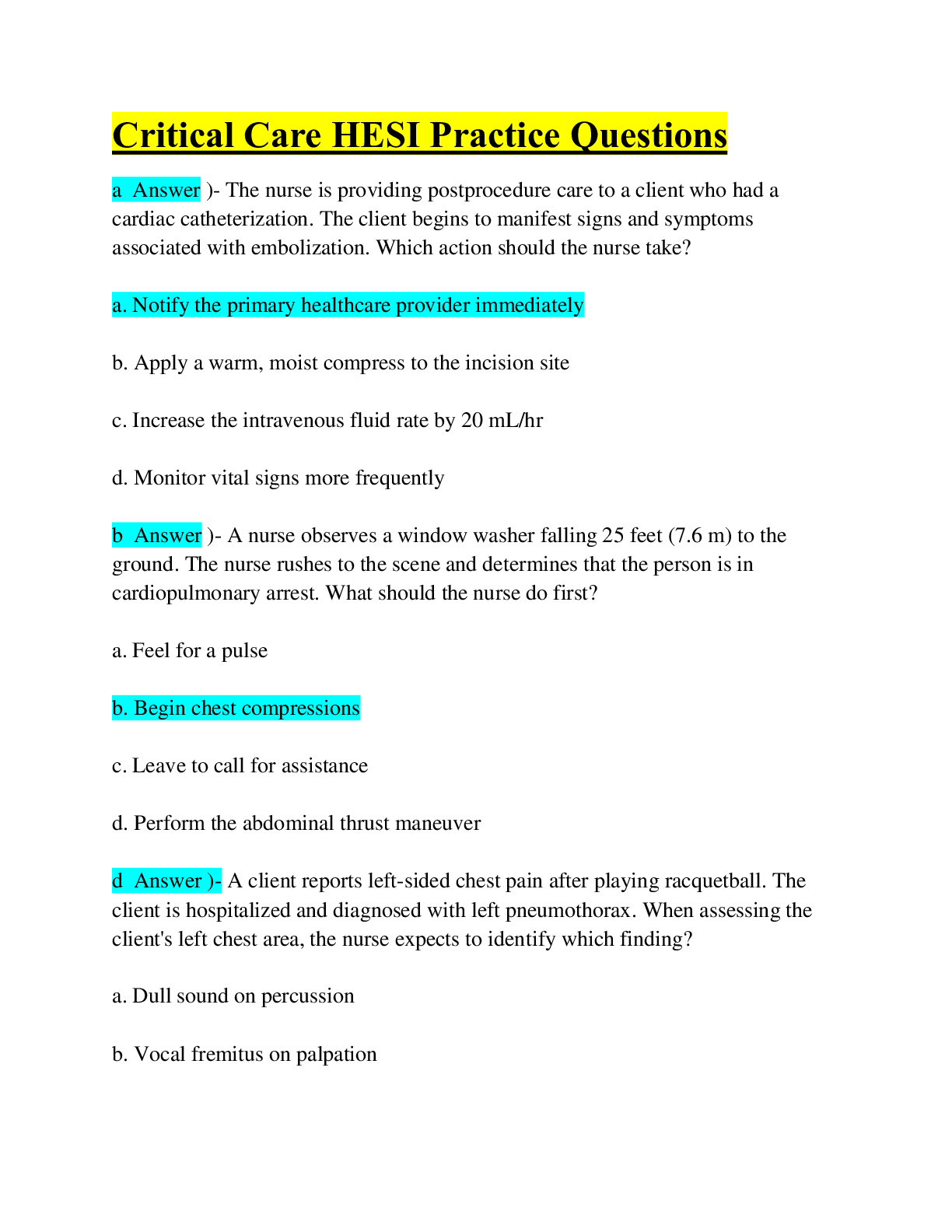


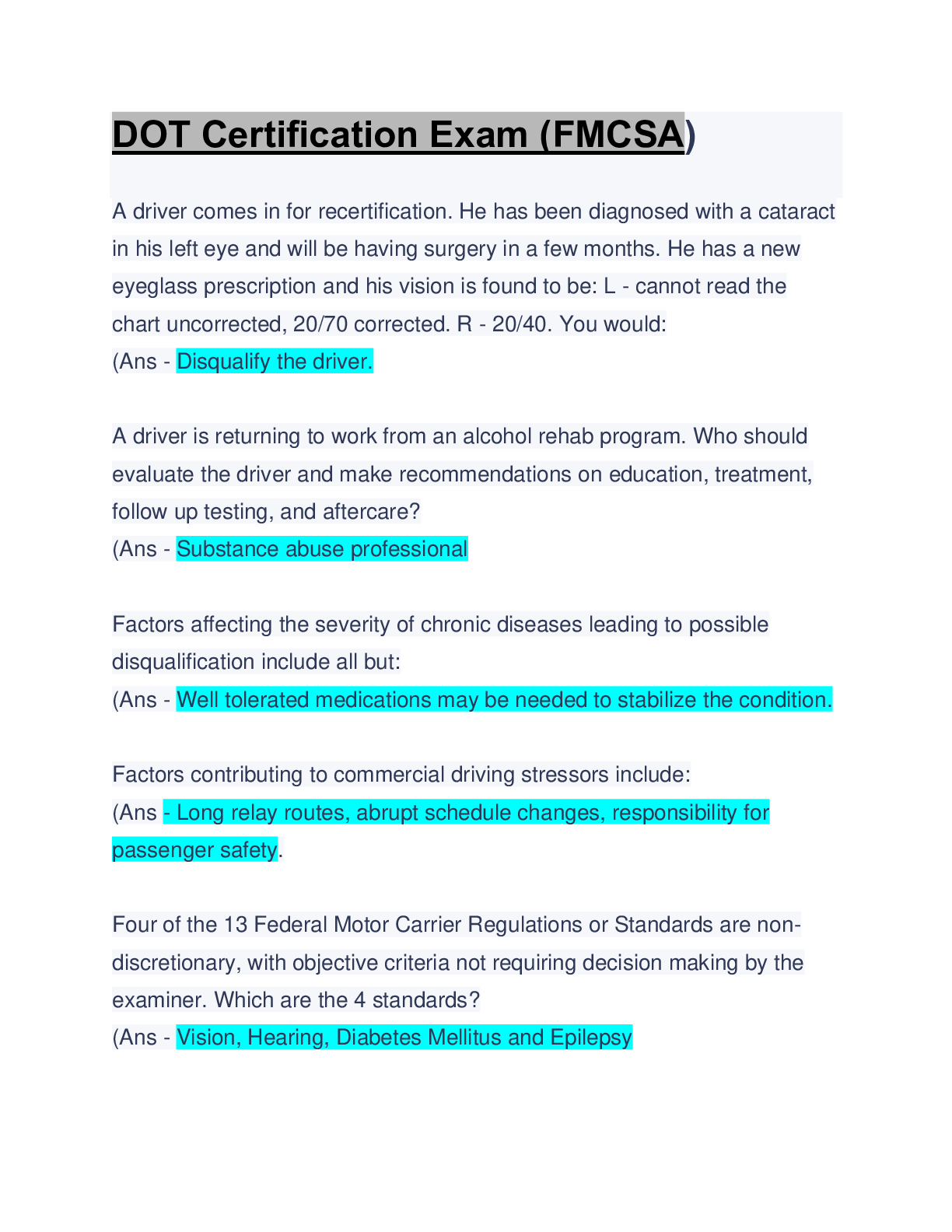

 RN HESI EXIT EXAM VERSIONS TEST BANK.png)
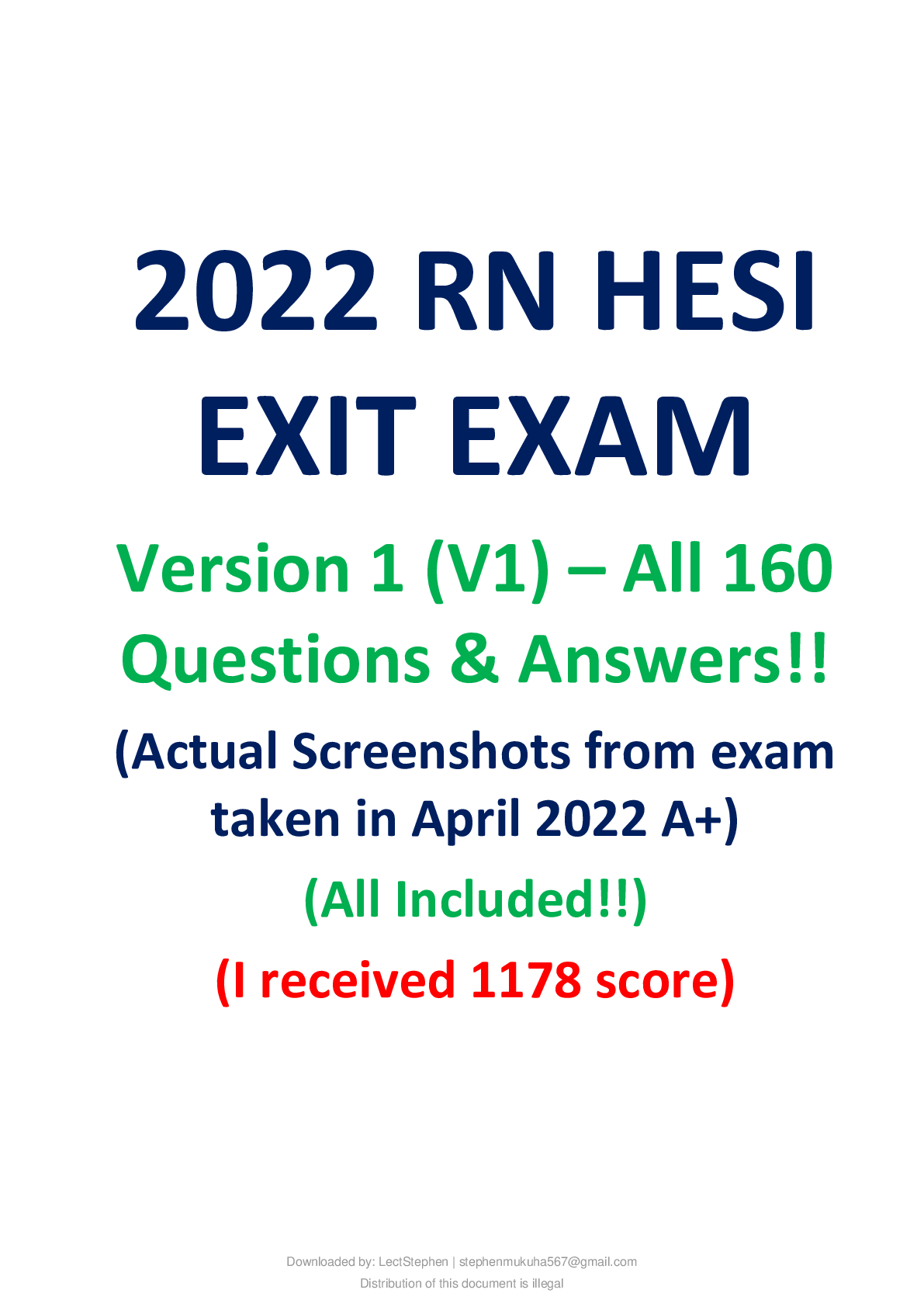
 -All 160 Questions & Answers.png)
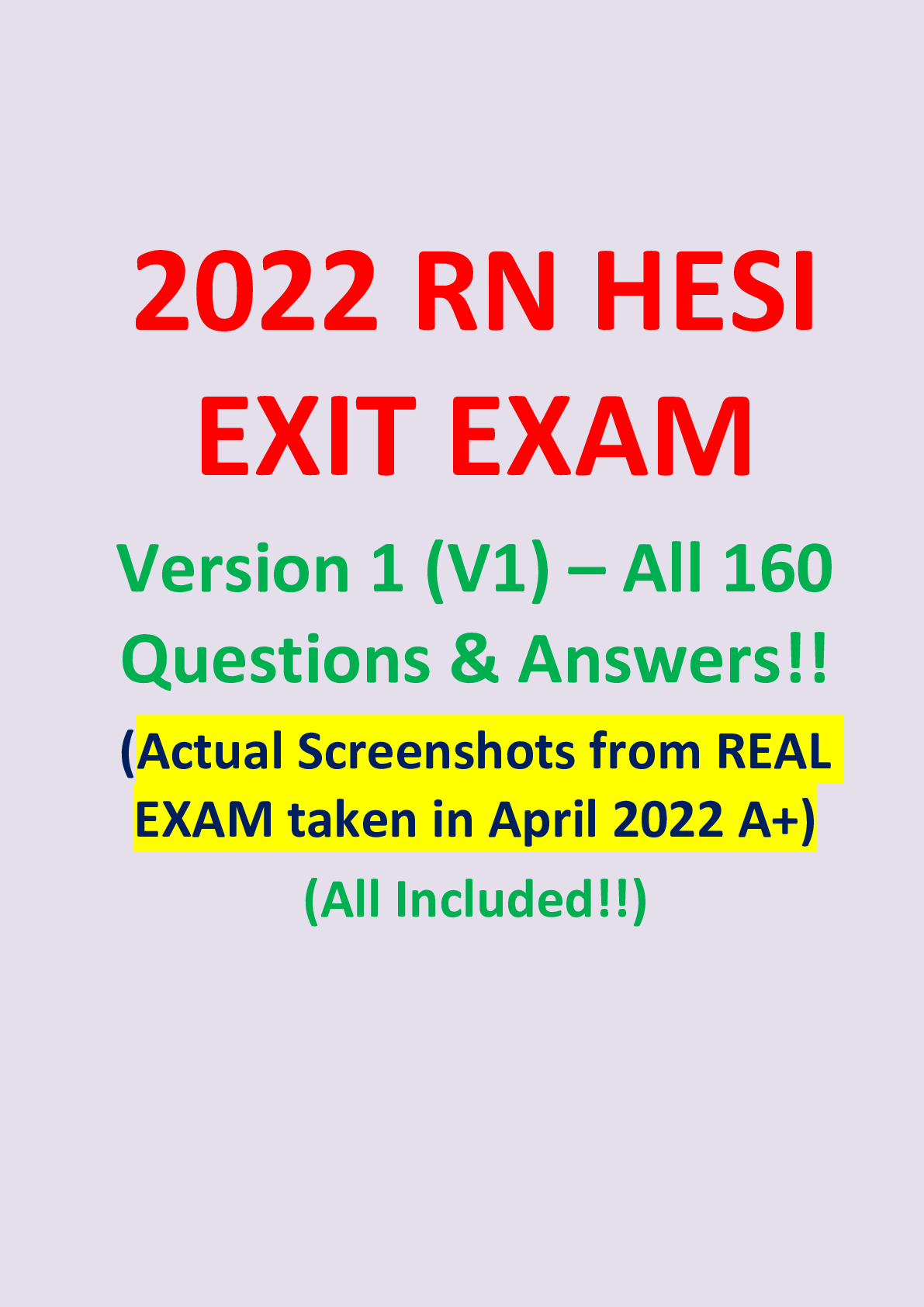
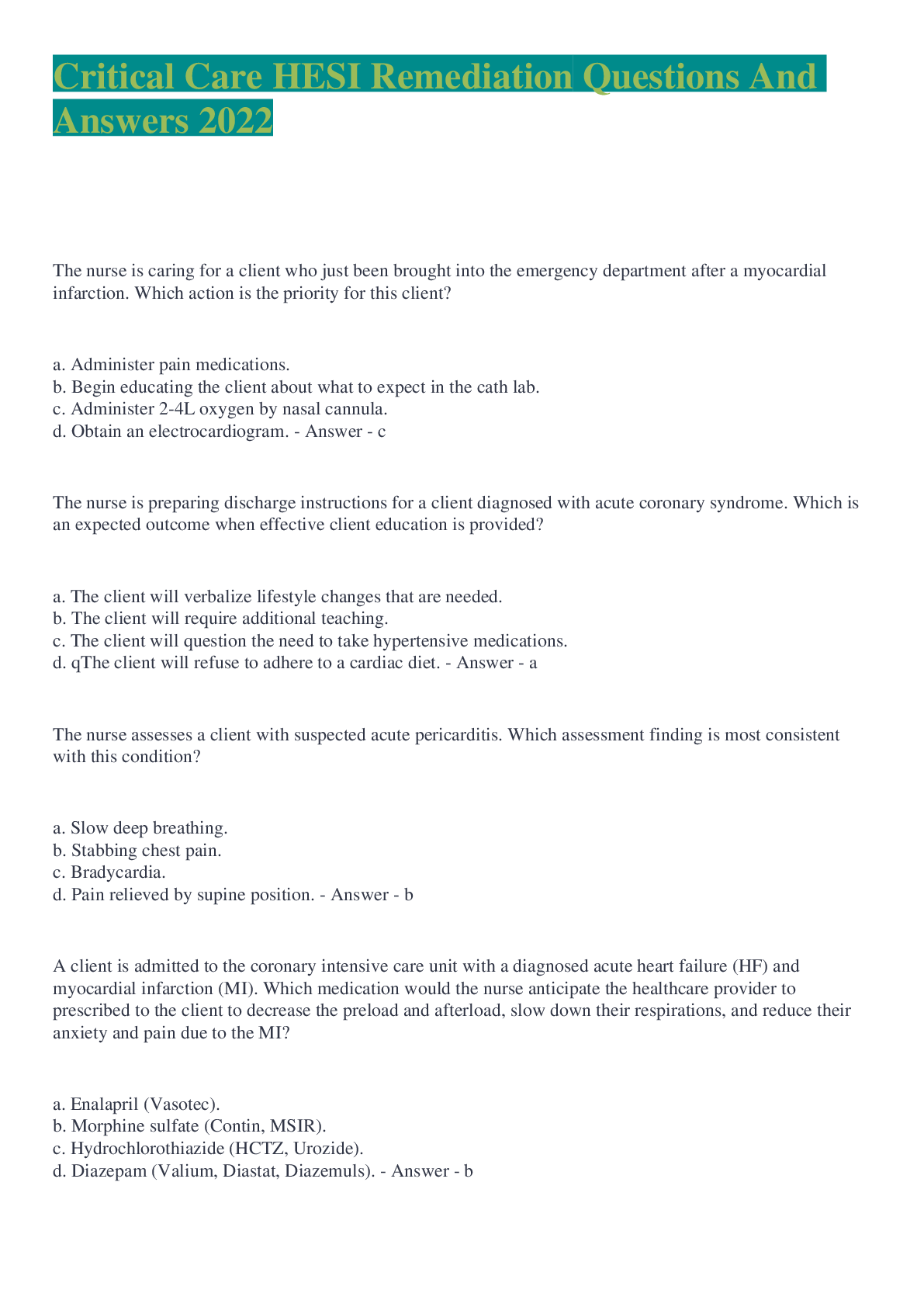



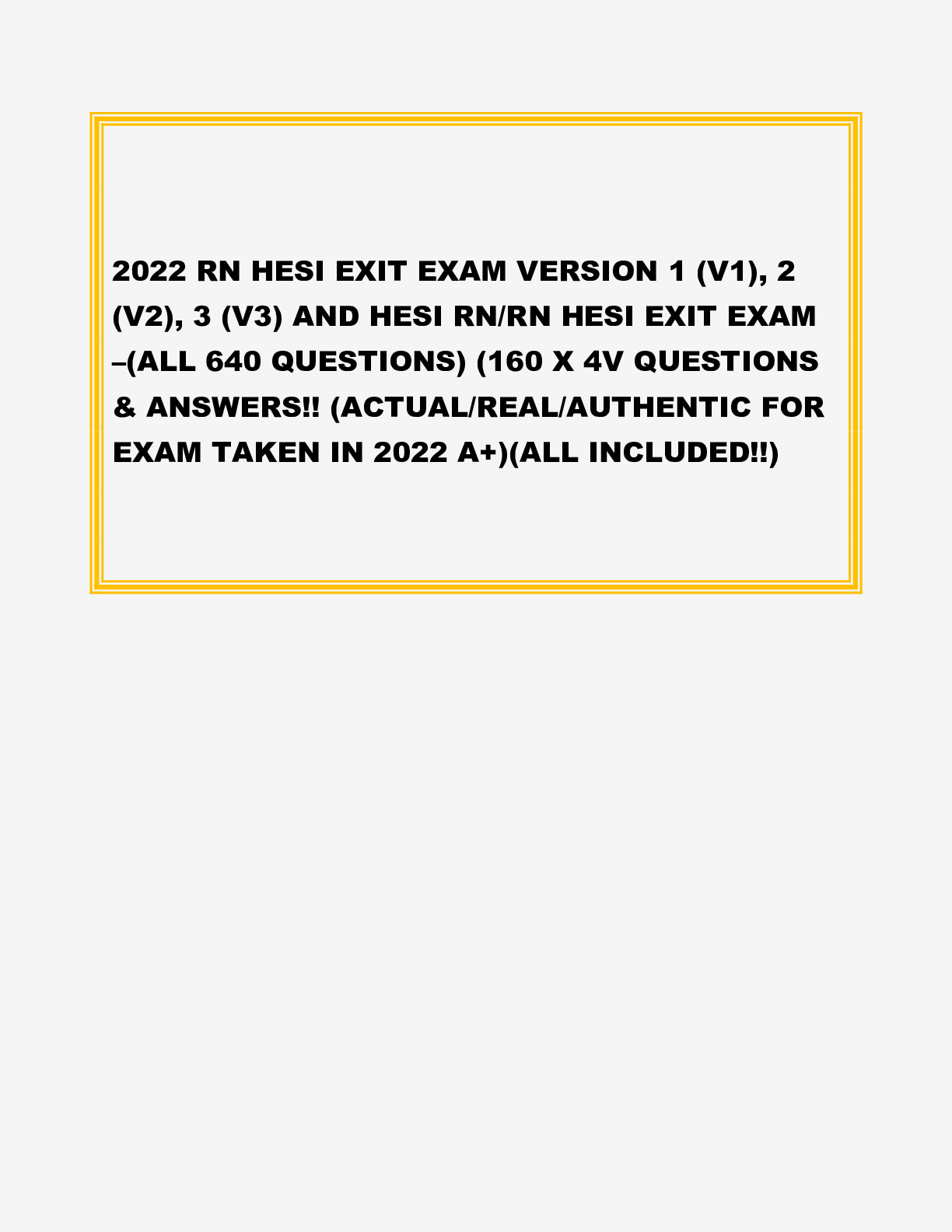

.png)

.png)
.png)
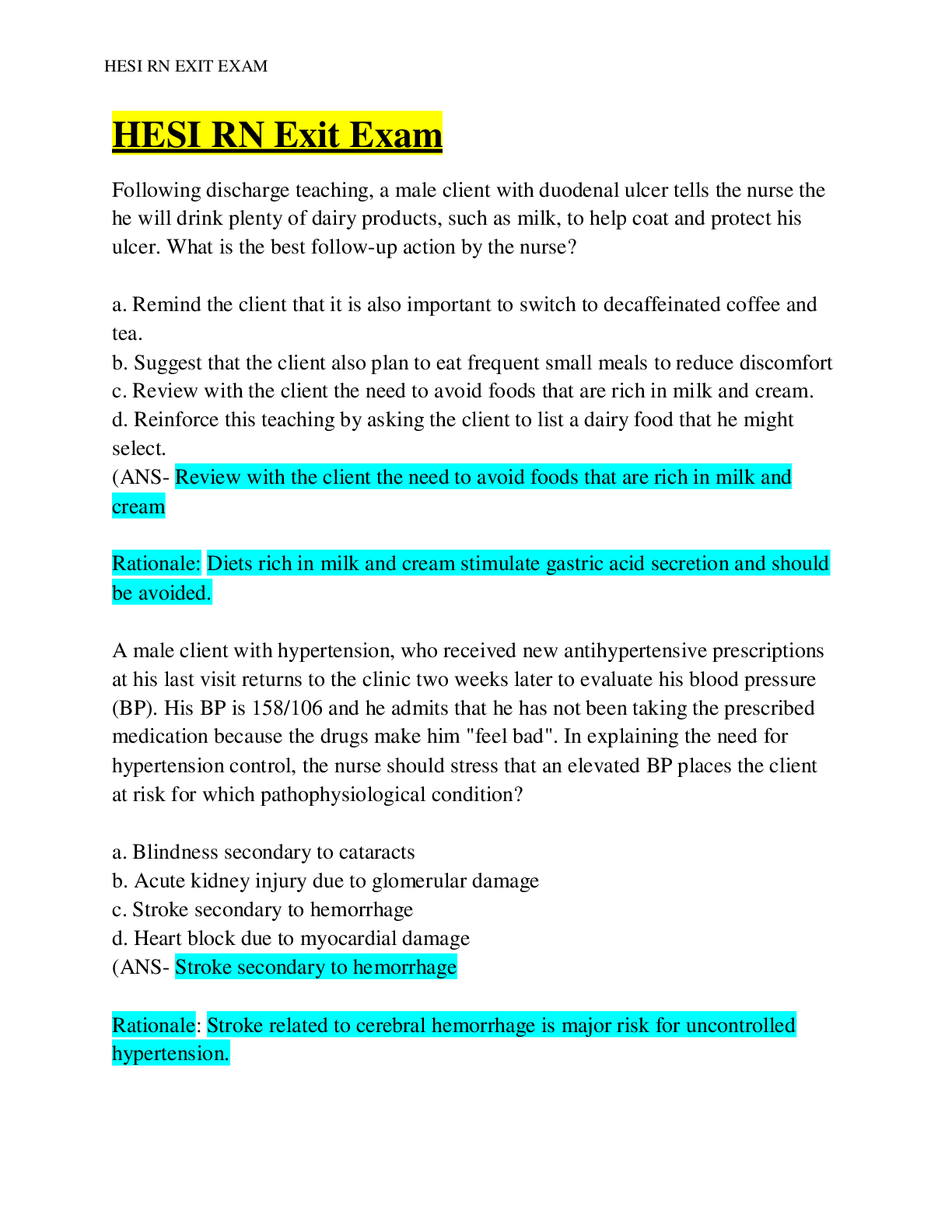
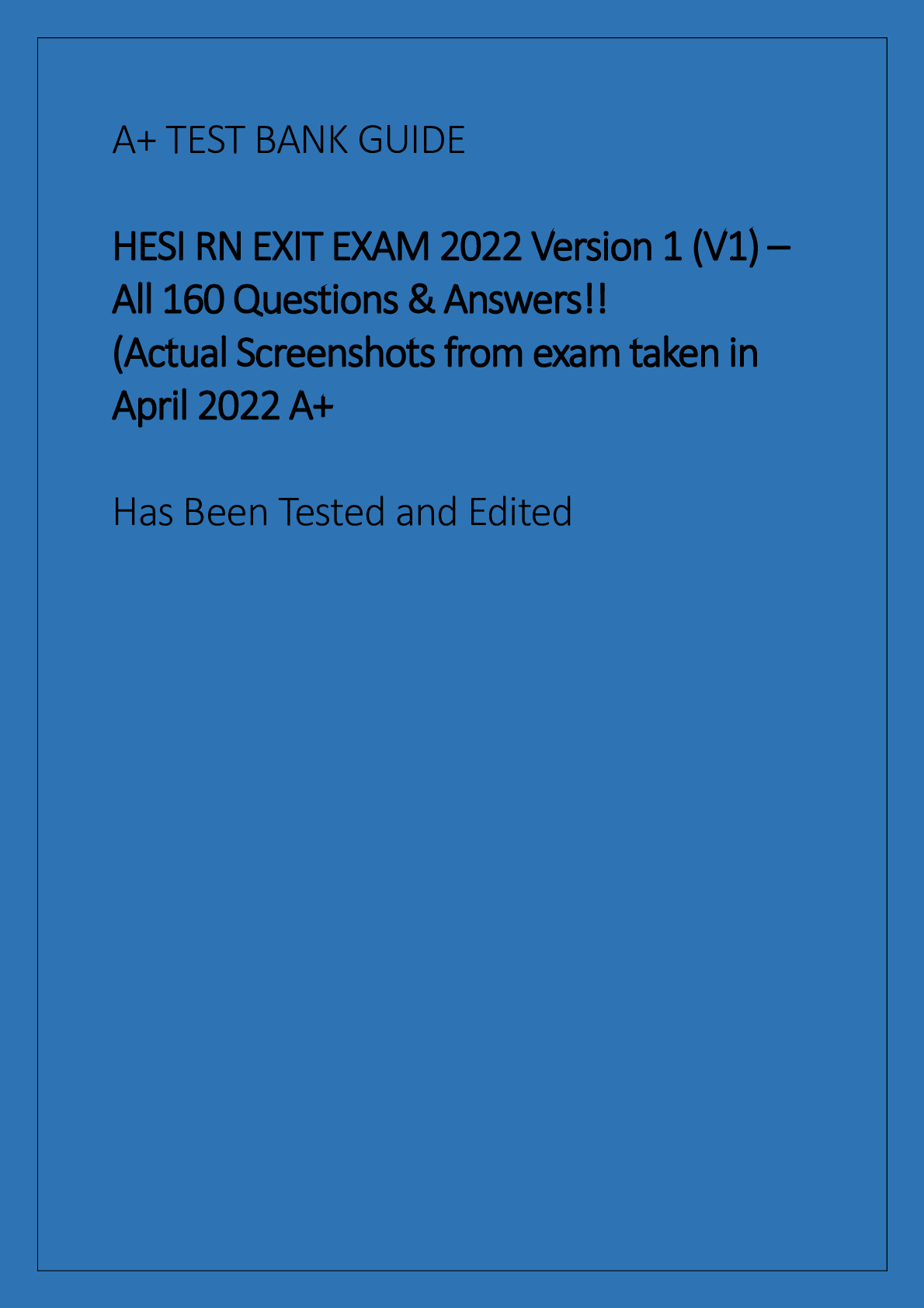
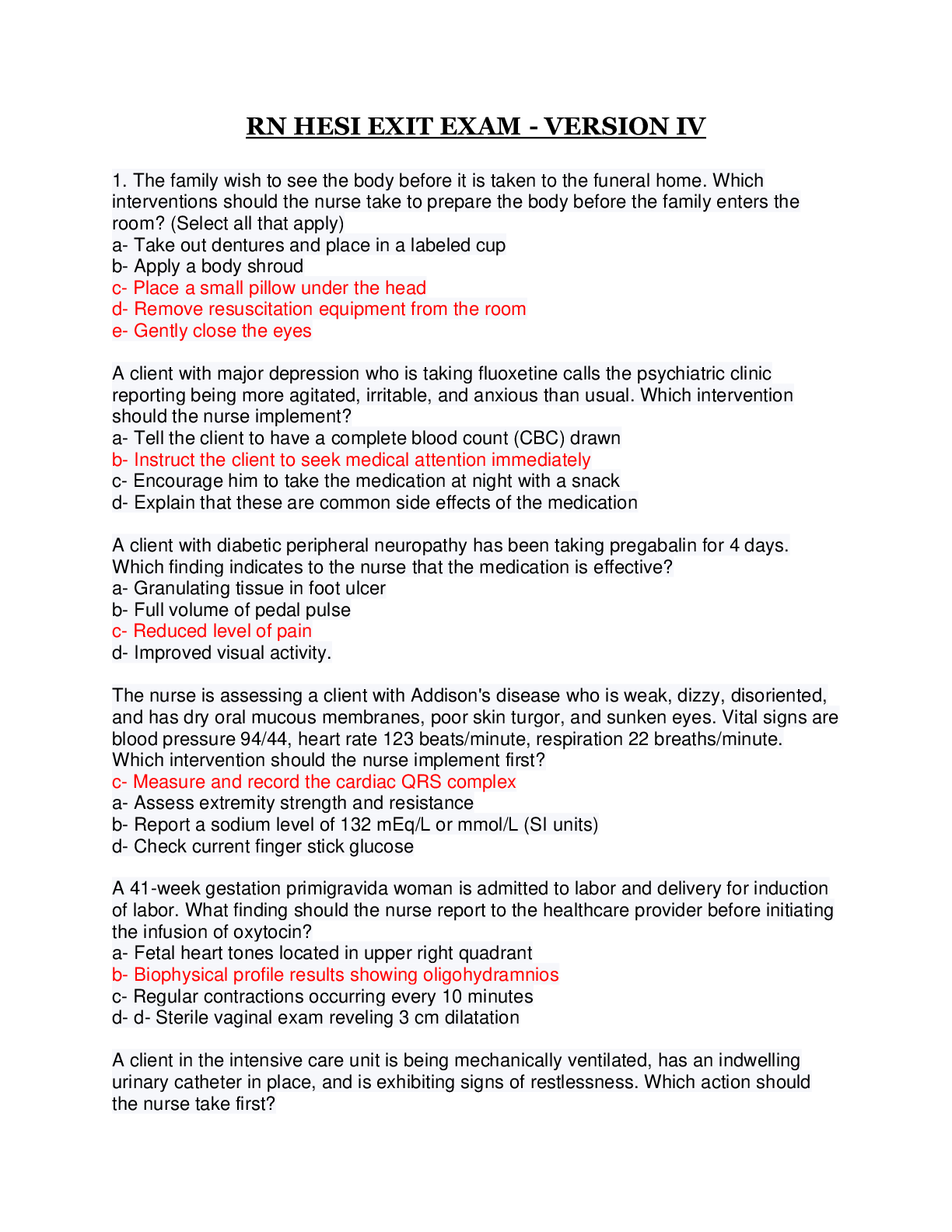
.png)

